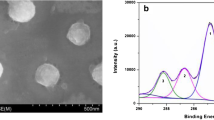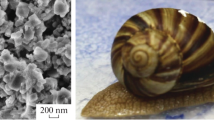Abstract
The development of nanotechnology has drawn increased attention to the risks of nanoparticles (NPs). In this work, the near-infrared persistent luminescence imaging technique was used to track the biodistribution of NPs in vivo in zebrafish. Zebrafish were used as a vertebrate animal model to show NPs distribution and the effects of exposure. ZnGa2O4:Cr (ZGOC) was chosen as the probe in this work. In continuous exposure experiments, the results showed more particles accumulated in the intestines than in the gills in both groups. In both the gills and abdomen, the NPs contents were greater in the ZGOC–NH2-treated groups than in the ZGOC groups, and the NPs caused damage to the gills and intestines. Removal exposure experiments indicated that ZGOC and ZGOC–NH2 could be excreted from the body. The metabolism, excretion of NPs, the quantification and monitoring of NPs behavior in biological systems should be examined in further studies.






Similar content being viewed by others
References
Bergin IL, Witzmann FA (2013) Nanoparticle toxicity by the gastrointestinal route: evidence and knowledge gaps. Int J Biomed Nanosci Nanotechnol. doi: https://doi.org/10.1504/IJBNN.2013.054515
Bisesi JH, Merten J et al (2014) Tracking and quantification of single-walled carbon nanotubes in fish using near infrared fluorescence. Environ Sci Technol 48(3):1973–1983
Borm P, Klaessig FC, Landry TD et al (2006) Research strategies for safety evaluation of nanomaterials, part V: role of dissolution in biological fate and effects of nanoscale particles. Toxicol Sci 90(1):23–32
Chermont QL, Chaneac C, Seguin J et al (2007) Nanoprobes with near-infrared persistent luminescence for in vivo imaging. Proc Natl Acad Sci USA 104(22):9266–9271
Deng X, Jia G, Wang H et al (2007) Translocation and fate of multi-walled carbon nanotubes in vivo. Carbon 45:1419–1424
Evans DH, Piermarini PM, Choe KP (2005) The multifunctional fish gill: dominant site of gas exchange, osmoregulation, acid–base regulation, and excretion of nitrogenous waste. Physiol Rev 85:97–177
Furman O, Usenko S, Lau BLT (2013) Relative importance of the humic and fulvic fractions of natural organic matter in the aggregation and deposition of silver nanoparticles. Environ Sci Technol 43:1349–1356
Leguen I, Prunet P (2004) Effect of hypotonic shock on cultured pavement cells from freshwater or seawater rainbow trout gills. Comp Biochem Physiol A 137:259–269
Li JL, Shi JP, Shen JS et al (2014) Specific recognition of breast cancer cells in vitro using near infrared-emitting long-persistence luminescent Zn3Ga2Ge2O10:Cr3+ nanoprobes. Nano–Micro Lett 7(2):138–145
Love DR, Pichler FB, Dodd A et al (2004) Technology for high-throughput screens: the present and future using zebrafish. Curr Opin Biotechnol 15:564
Mahmoudi M, Stroeve P, Milani AS et al (2010) Superparamagnetic iron oxide nanoparticles for biomedical applications. Nova Science Publishers, Inc. ISBN 978-1-61668-964-3
Maldiney T, Bessière A, Seguin J et al (2014) The in vivo activation of persistent nanophosphors optical imaging of vascularization, tumors and grafted cells. Nat Mater 13(4):418–426
Moller P, Jacobsen NR, Folkmann JK et al (2010) Role of oxidative damage in toxicity of particulates. Free Radic Res 44(1):1–46
Nel A, Xia T, Madler L et al (2006) Toxic potential of materials at the nanolevel. Science 311:622–627
Rallo R, France B, Liu R et al (2011) Self-organizing map analysis of toxicity-related cell signaling pathways for metal and metal oxide nanoparticles. Environ Sci Technol 45(4):1695–1702
Renaud G, Hamilton RL, Havel RJ (1989) Hepatic metabolism of colloidal gold-low-density lipoprotein complexes in the rat: evidence for bulk excretion of lysosomal contents into bile. Hepatology 9:380–392
Saxena RK, Williams W, Mcgee JK et al (2007) Enhanced in vitro and in vivo toxicity of poly-dispersed acid-functionalized single-wall carbon nanotubes. Nanotoxicology 1:291–300
Shi JP, Sun X, Li JL et al (2015) Multifunctional near infrared-emitting long-persistence luminescent nanoprobes for drug delivery and targeted tumor imaging. Biomaterials 37:260–270
Singh R, Pantarotto D, Lacerda L et al (2006) Tissue biodistribution and blood clearance rates of intravenously administered carbon nanotube radiotracers. Proc Natl Acad Sci USA 103:3357–3362
Stern HM, Zon LI (2003) Cancer genetics and drug discovery in the zebrafish. Nat Rev Cancer 3:533
Sun X, Shi JP, Zheng SH et al (2018) Visualization of inflammation in a mouse model based on near-infrared persistent luminescence nanoparticles. J Lumin 204:520–527
Wiesner MR et al (2006) Assessing the risks of manufactured nanomaterials. Environ Sci Technol 40(14):4336–4345
Yang RSH, Chang LW, Wu JP et al (2007) Persistent tissue kinetics and redistribution of nanoparticles, quantum dot 705, in mice: ICP-MS quantitative assessment. Environ Health Perspect 115:1339–1343
Zhu X, Wang J, Zhang X, Chang Y, Chen Y (2010) Trophic transfer of TiO2 nanoparticles from daphnia to zebrafish in a simplified freshwater food chain. Chemosphere 79(9):928–933
Zou R, Gong SM et al (2017a) Magnetic-NIR persistent luminescent dual-modal ZGOCS@MSNs@Gd2O3 core–shell nanoprobes for in vivo imaging. Chem Mater 29(9):3938–3946
Zou R, Huang JJ et al (2017b) Silica shell-assisted synthetic route for mono-disperse persistent nanophosphors with enhanced in vivo recharged near-infrared persistent luminescence. Nano Res 10(6):2070–2082
Acknowledgements
Thanks for financial support from the Bureau of International Cooperation, the Chinese Academy of Sciences (132C35KYSB20160021), The National Natural Science Foundation of China (21507129, 61705228), The Natural Science Foundation of Fujian Province, China (2018J05028).
Author information
Authors and Affiliations
Corresponding author
Electronic supplementary material
Below is the link to the electronic supplementary material.
Rights and permissions
About this article
Cite this article
Wang, C., Zheng, S., Zou, X. et al. A Near-infrared Persistent Luminescence Imaging Technique for Tracking Nanoparticles in Zebrafish (Danio rerio). Bull Environ Contam Toxicol 103, 267–273 (2019). https://doi.org/10.1007/s00128-019-02642-w
Received:
Accepted:
Published:
Issue Date:
DOI: https://doi.org/10.1007/s00128-019-02642-w




